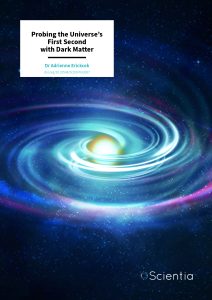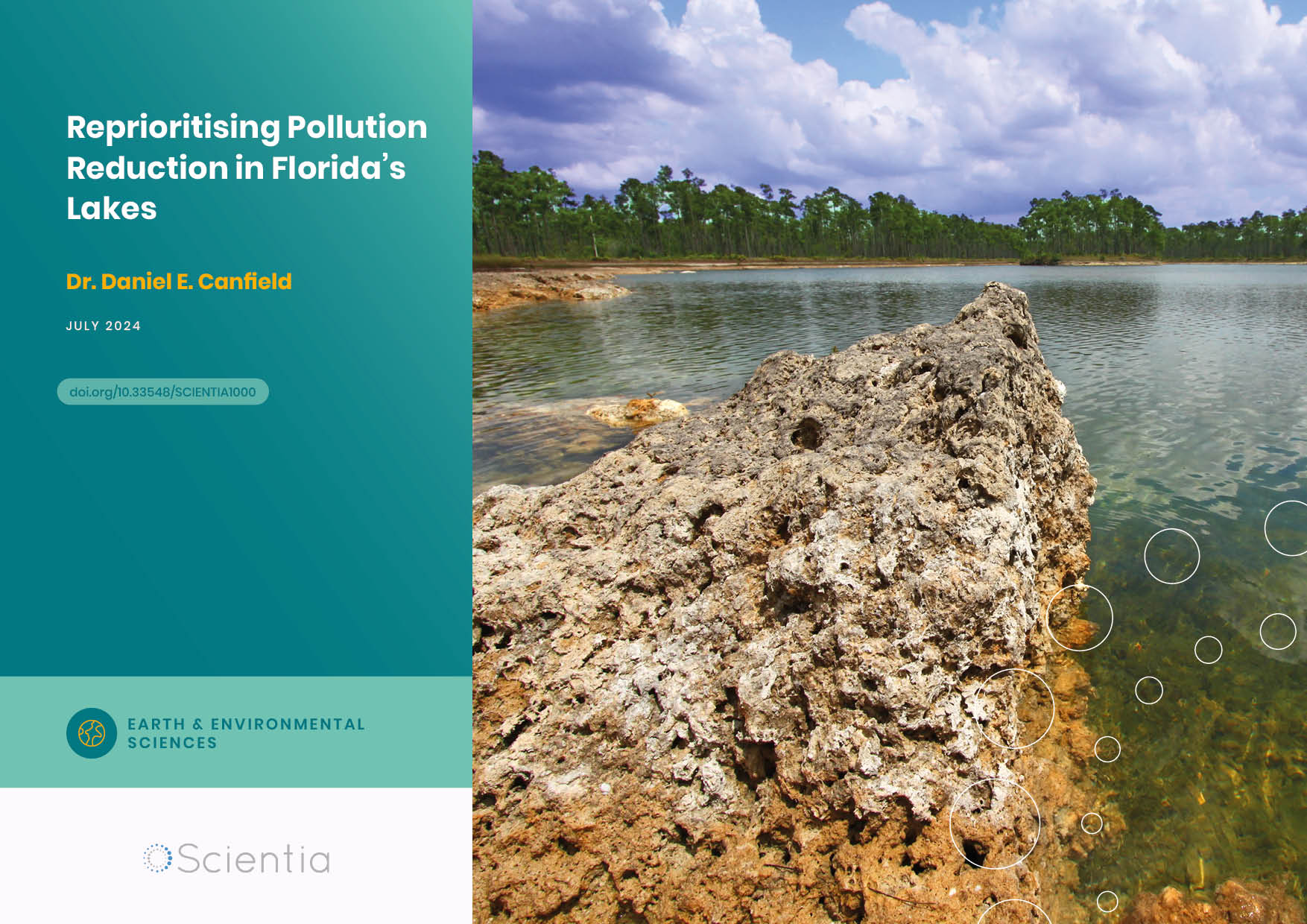Dr Adrienne Erickcek | Probing the Universe’s First Second with Dark Matter
The secrets of dark matter have eluded scientists for decades. Dr Adrienne Erickcek at the University of North Carolina is working with colleagues to provide new insights into this mysterious substance. The team is currently investigating how the expansion history of the early Universe affects how dark matter is distributed throughout the cosmos and the implications these structures have for the origins of dark matter itself.
The Expansion of the Universe
The Universe has been expanding since the first moment of the Big Bang. However, the expansion rate of the Universe throughout its 13.8-billion-year history has been anything but constant. The history of the Universe can be broadly divided into three eras based on the dominant component of the energy density at that time. In chronological order, they are the radiation-dominated, matter-dominated, and dark energy-dominated eras.
Approximately 4 billion years ago, the density of dark energy in the Universe exceeded both the density of matter and the density of radiation. This means we currently live in a dark energy-dominated era. The dominance of dark energy in the Universe is what is now causing the Universe’s expansion to accelerate.
But let’s rewind the clocks a bit – for the first 380,000 years after the Big Bang, the Universe was so dense and hot that atoms couldn’t even form. The Universe was opaque to light during this time because all forms of electromagnetic radiation were scattered by free electrons. We primarily rely on light to study the cosmos, so this makes studying the early Universe particularly challenging. Nevertheless, we know that the Universe’s energy density was dominated by radiation during its first minutes. Protons and neutrons combined to form the first helium nuclei during this time in a process called Big Bang Nucleosynthesis. By measuring the abundance of helium and other light elements in the Universe, we can determine that the Universe was radiation-dominated 0.1 seconds after the Big Bang. Radiation domination continued until the Universe expanded and cooled enough for the density of matter in the Universe to exceed the density of radiation about 52,000 years after the Big Bang.
Unfortunately, we do not know what happened prior to the onset of Big Bang Nucleosynthesis. There is strong evidence that the Universe inflated exponentially during its first nanosecond, but very little is known about the first moments after this period of cosmic inflation ended. This gap in the cosmological record may sound short, but the Universe was a hot and active place for its first tenth of a second. In this brief time, normal matter was created, and it seems likely that dark matter traces its origins to this period as well.
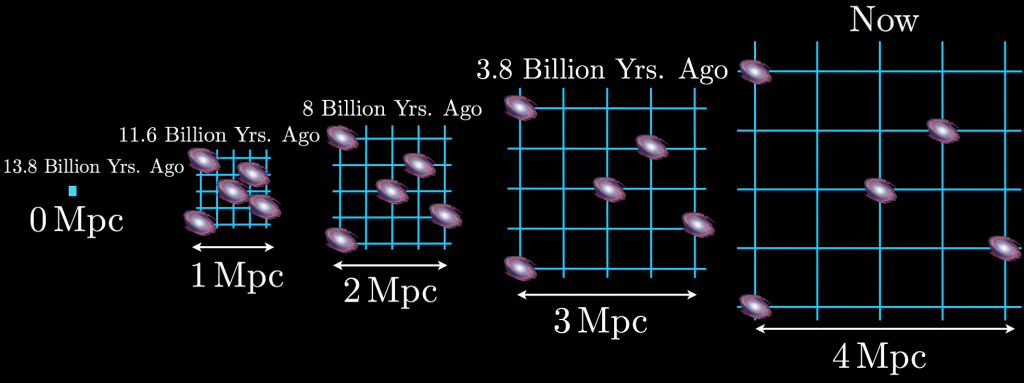
The distances between galaxies increase as the Universe expands. Credit: Adrienne Erickcek.
What is Dark Matter and Why Does it Matter?
Dark matter is a form of matter that does not interact with the electromagnetic force – it does not reflect, emit, or absorb light in any way and is, therefore, difficult to observe directly. In fact, we only know dark matter exists due to its gravitational effect on objects we can observe directly, such as stars and gas. It is estimated that dark matter constitutes about 85% of the total matter in the Universe; its density is more than five times that of ordinary atomic matter. Investigating this mysterious form of matter is of critical importance to our understanding of the cosmos.
You might be wondering just what dark matter is exactly. The truth is that nobody knows: no known particle has the required properties to be dark matter. Dark matter might be just one kind of particle, or it might be a mixture of different types of particles that make up a dark universe we cannot see. Scientists do have some ideas, though – potential dark matter candidates include (but are not limited to) weakly interacting massive particles (amusingly abbreviated as WIMPS), axions, or sterile neutrinos.
While the naming of dark energy and dark matter might imply similarity, the terms should not be confused. Dark energy is a repulsive actor that accelerates the expansion of the Universe, whereas dark matter has mass and interacts attractively with the same gravitational force as normal matter.
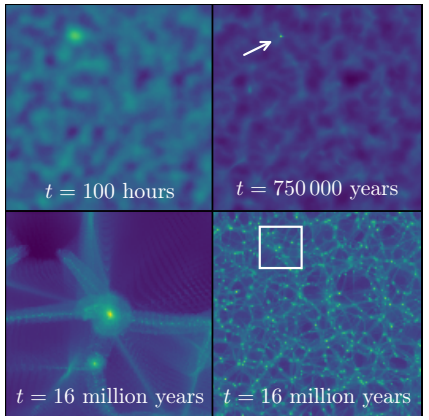
A simulation of the formation of the first dark matter halos: the bottom left image shows a closer view of the region in the white box in the bottom right image. Credit. MS Delos.
Was the Early Universe Dominated by Matter?
Recent theories suggest there was at least one short epoch of matter domination prior to the end of the radiation-dominated era. An early matter-dominated era (EMDE) occurs when very heavy and unstable particles dominate the energy density of the Universe before they decay.
Dr Adrienne Erickcek at the University of North Carolina is working with colleagues to determine how an EMDE affects dark matter. Their research gives new perspectives into the early Universe and how it affects the structures that exist today. It also provides a new way to explore the origins of dark matter. ‘The evolution of the Universe between inflation and the onset of Big Bang Nucleosynthesis is difficult to probe and largely unconstrained,’ says Dr Erickcek. ‘This ignorance profoundly limits our understanding of dark matter.’
An EMDE widens the field of potential dark matter candidates beyond what was conventionally thought possible. Indeed, dark matter particles may, in fact, be more weakly interacting and more difficult to detect than previously believed. Fortunately, Dr Erickcek’s research has shown that an EMDE also provides a means of detecting such elusive dark matter. The density of dark matter is not the same throughout the Universe. Density perturbations give rise to regions that contain slightly more or slightly less dark matter than the cosmic average. Dark matter particles in denser regions form gravitationally bound clumps called dark matter halos. These clumps then merge to form larger and larger halos. Galaxies formed inside the gravitational influence of these dark matter halos, making them very important to the study of the structure of the Universe.
Dr Erickcek and her team calculated that if the Universe experienced an EMDE, then dark matter density perturbations on small scales would grow more rapidly than in a standard radiation-dominated model. As a result, an EMDE generates a large population of sub-Earth-mass dark matter microhalos that form long before the first halos appear in standard cosmological models.
In fact, Dr Erickcek and her collaborators demonstrated that an EMDE could lead to halo formation while the Universe was still radiation-dominated. If dark matter interacts with normal matter through a weak force, it is generally too hot to form halos this early. However, the fact that the Large Hadron Collider has not detected any particles beyond the Standard Model has led many researchers to speculate that dark matter is part of a ‘hidden sector’ and does not interact with normal matter except through gravity. In this case, the dark matter would be cold enough to form structures during the radiation-dominated era following an EMDE.
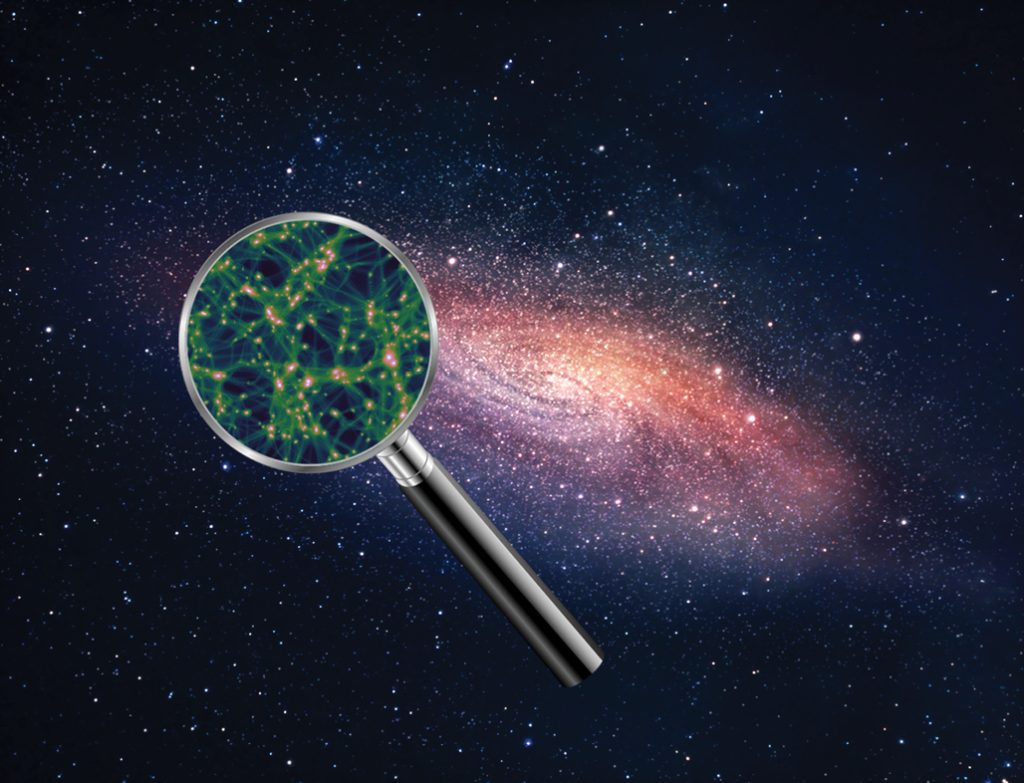
Credit: Adrienne Erickcek
Probing the Origins of Dark Matter
To better understand the impact the early Universe had on dark matter, Dr Erickcek and her colleagues considered two distinct possibilities. In the first scenario, Dr Erickcek assumes that dark matter was created thermally, meaning it was forged via pair production in the very hot, early Universe. Pair production is the spontaneous production of a matter-antimatter pair from high-energy photons or other electrically neutral particles. In this scenario, dark matter is composed of both matter and antimatter. We call these dark matter particles thermal relics, as they are left over from the hot moments after the Big Bang.
If dark matter is a thermal relic, the enhanced microhalo population generated by an EMDE boosts the dark matter annihilation rate. When matter and antimatter particles collide, they will annihilate each other, converting their combined mass into high-energy particles and gamma rays. This is true for dark matter as well as visible matter. In the hot and dense early Universe, these dark matter annihilation events were common, but so was the pair production of dark matter particles. Eventually, the Universe became too cold to produce dark matter, and the dark matter density decreased to the point that dark matter particles rarely collided. Microhalos bring dark matter particles back together, making it easier for particles to annihilate.
The gamma rays generated by dark matter annihilation would contribute to the observed isotropic gamma-ray background (IGRB). Using data obtained from the Fermi Gamma-Ray Space Telescope, Dr Erickcek and her fellow researchers were able to determine an upper limit for the probability of dark matter annihilation that accounts for the boosted annihilation rate after an EMDE. This helps us put constraints on how dark matter could have been produced in the early Universe, allowing us to better understand the nature of these invisible particles.
Some theorists suggest that dark matter could be unstable, albeit with a half-life longer than the current age of the Universe. If dark matter particles are indeed unstable, they will emit high-energy gamma rays when they decay, which would emit a signal similar to the annihilation signals from microhalos in the IGRB. This is, unfortunately, problematic as it becomes difficult to differentiate the two signals. Fortunately, Dr Erickcek’s team showed that the disruption of microhalos by stars and tides in galactic centres leads to a distinct signature that could be used to differentiate between these two scenarios if gamma rays from dark matter are eventually detected.
Recall that we mentioned earlier that there were two possible methods of dark matter generation in the hot, early Universe. We will now focus on the latter, where dark matter particles were produced nonthermally. Essentially, this means that the dark matter particles were generated by mechanisms other than pair production.
One possible method of the nonthermal production of dark matter is the decay of the field that caused the EMDE. In their research published in 2020, Dr Erickcek and her student characterised the nonthermal production of dark matter during an EMDE. They found that the vast majority of dark matter produced through this process would be moving at relativistic speeds at the end of the EMDE. This means the dark matter particles would be travelling too fast to coalesce into sub-Earth-mass microhalos, although they would still be able to form galactic-size halos.
In fact, dark matter particles created nonthermally might have travelled so fast and been so hot that they disrupted and even erased larger structures. By studying the abundance of satellite galaxies orbiting the Milky Way and other probes of sub-galactic structures, Dr Erickcek’s team constrained the range of dark matter candidates that could have been produced nonthermally during an EMDE. Like the constraints they established on the thermal production of dark matter, these results narrow the field of potential dark matter particles.
The more we learn about what dark matter is not, the better we can direct our searches for it. And as we learn about dark matter, we can use it as a probe to understand the evolution of the early Universe.
SHARE
DOWNLOAD E-BOOK
REFERENCE
https://doi.org/10.33548/SCIENTIA1007
MEET THE RESEARCHER

Dr Adrienne Erickcek
Associate Professor
Department of Physics and Astronomy
University of North Carolina
Chapel Hill, NC
USA
Dr Adrienne Erickcek received her PhD in physics from the California Institute of Technology in 2009. She had previously earned an AB in physics from Princeton University in 2003 and a master’s of advanced study in mathematics at the University of Cambridge in 2004. After earning her PhD, Dr Erickcek spent four years as a post-doctoral fellow at the Canadian Institute for Theoretical Physics and the Perimeter Institute for Theoretical Physics. She then made the move in 2013 to the University of North Carolina, where she now serves as an associate professor in the Department of Physics and Astronomy. Dr Erickcek’s recent research focuses on investigating dark matter and the evolution of the early universe. She was awarded a CAREER award from the National Science Foundation, and she has published extensively in her field. In 2023, Dr Erickcek was awarded an American Physical Society Fellowship for her contributions to theoretical cosmology, particularly her study of small-scale density fluctuations in the early Universe.
CONTACT
E: erickcek@physics.unc.edu
W: www.physics.unc.edu/~erickcek
KEY COLLABORATORS
Dr Carlos Blanco, University of Chicago (now at Princeton University)
Dr M. Sten Delos, University of North Carolina (now at Carnegie Observatories)
Dr Dan Hooper, University of Chicago
Dr Carisa Miller, University of North Carolina
Dr Tim Linden, The Ohio State University (now at Stockholm University)
FUNDING
National Science Foundation
NASA Fermi Guest Investigator Program
FURTHER READING
C Blanco, MS Delos, A Erickcek, D Hooper, Annihilation signatures of hidden sector dark matter within early-forming microhalos, Physical Review D, 2019, 100, 103010. DOI: https://doi.org/10.1103/PhysRevD.100.103010
C Miller, A Erickcek, R Murgia, Constraining Nonthermal Dark Matter’s Impact on the Matter Power Spectrum, Physical Review D, 2019, 100, 123520. DOI: https://doi.org/10.1103/PhysRevD.100.123520
M S Delos, T Linden, A Erickcek, Breaking a dark degeneracy: The gamma-ray signature of early matter domination, Physical Review D, 2019, 100, 123546. DOI: https://doi.org/10.1103/PhysRevD.100.123546
A Erickcek, The dark matter annihilation boost from low-temperature reheating, Physical Review D, 2015, 92, 103505,
DOI: https://doi.org/10.1103/PhysRevD.92.103505

REPUBLISH OUR ARTICLES
We encourage all formats of sharing and republishing of our articles. Whether you want to host on your website, publication or blog, we welcome this. Find out more
Creative Commons Licence (CC BY 4.0)
This work is licensed under a Creative Commons Attribution 4.0 International License. 
What does this mean?
Share: You can copy and redistribute the material in any medium or format
Adapt: You can change, and build upon the material for any purpose, even commercially.
Credit: You must give appropriate credit, provide a link to the license, and indicate if changes were made.
SUBSCRIBE NOW
Follow Us
MORE ARTICLES YOU MAY LIKE
Dr Arne Stensvand | Thermotherapy: Effective Disease and Pest Management Without Chemicals
Dr Arne Stensvand and his team at the Norwegian Institute of Bioeconomy Research are developing physical methods of pest reduction in plants. The team is specifically interested in strawberry plants, for which pest management is vital for crop success. They are pioneering thermotherapy as a heat treatment method to provide an environmentally effective and economically sound non-chemical approach to pest management.
Dr. Daniel Canfield | Reprioritising Pollution Reduction in Florida’s Lakes
Florida’s landscape is dotted with thousands of lakes that reflect regional geology, topography and anthropogenic activities. Phosphorus and nitrogen are critical nutrients for maintaining the wide range of biological production expressed across Florida, but excessive inputs of these nutrients due to past human activities impair many waters. There has been a long history of work aiming to address associated water quality pressures, and Dr. Daniel Canfield at the University of Florida has been at the centre of these efforts for over 40 years. Now, with the correction of point-source nutrient inputs, Dr. Canfield proposes that holistic lake management, including the integration of in-lake management strategies with a focus on organic sediment removal, should be much more prominent on the US government’s agenda to provide faster restoration of stakeholders’ lake usability.
Dr Jon Tore Lieng | Dynamically Installed Anchors for Floating Offshore Turbines
Effectively harnessing offshore wind presents a valuable opportunity to increase energy supplies. Floating wind turbines present several advantages over traditional fixed turbines in more shallow waters. Dr Jon Tore Lieng from Deep Sea Anchors and colleagues have developed a type of dynamically installed anchor to hold the structures in place while reducing both the costs and complexity associated with installation where cohesive seabed sediments are realised.
Dr Lifei Wang | Can Species Distribution Models Inform Us About Future Ecosystems?
The world is buzzing with news about how human activities and climate shifts are reshaping our ecosystems. Have you ever wondered how life will adapt to this rapidly changing world? Ecologists might be able to predict how different species will live in future using computer simulations. Dr Lifei Wang at the University of Toronto Scarborough investigates how different stimulations work under varying conditions to provide new insights into what may lie ahead.

